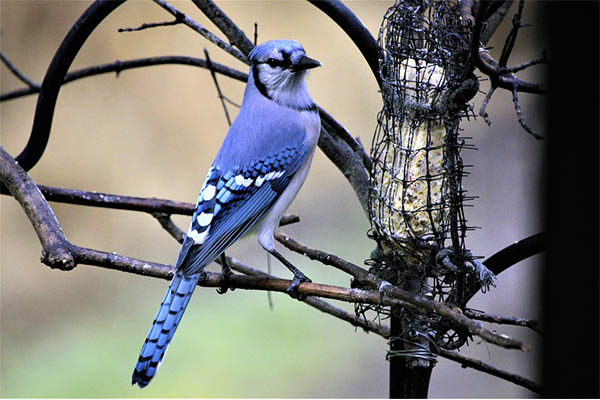
photo credit: Scottslm from Pixabay
The Blue Jay is probably one of the best-looking birds you can find in your backyard. They are known to be very noisy and are bullies for other birds. You can easily identify them from their blue and white color pattern, long tail, rounded wings, and steady flight. They also usually visit the backyard in packs, and there are just a lot of fascinating things you’ll love to know about this bird.
In this article, we are going to cover a wide variety of topics related to the Blue Jay, such as:
- How to identify them
- How, when, and where they migrate
- Their diet
- How and where they nest
- And much more…
So, without any more delay…
Blue Jay Facts
- Common Name: Blue Jay
- Scientific Name: Cyanocitta cristata
- Scientific Family: Corvidae
- Life Span: 7 years
- Size: 9.8 to 11.8 inches
- Wingspan: 13.4 to 16.9 inches
- Weight: 2.5 to 3.5 oz
- Conservation status: Least Concern
How To Identify A Blue Jay
Blue Jays are easily identifiable from their beautiful blue and white color pattern. They are considered large-sized birds, and you can clearly see the distinct blue back portion and the white front portion of their bodies.
These birds have a black sturdy bill, their blue wings have black bars and white patches, and their blue tail also has black bars and white corners. When flying, you’ll notice that everything under the bird ranges from gray color to white. You’ll also notice a black eyeline and what appears to be a black necklace on their breast area.
Overall, these are very lovely birds that you can easily recognize from afar.
Differences Between Male & Female
There’s not any significant difference between the appearance of a male and a female Blue Jay. However, it has been noted that males tend to be larger than females.
Differences In Summer Plumage vs Winter Plumage
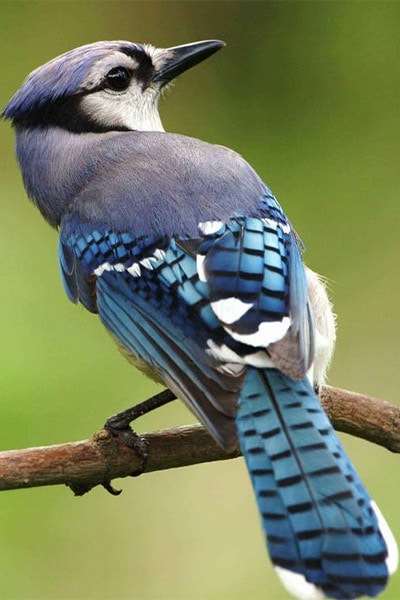
photo credit: Pixabay from Pexels
Blue Jays change plumage around June to July each year. However, instead of changing colors, they instead lose their feathers temporarily. So, they go bald, and this exposes the gray and black skin underneath. It only lasts for a week, though, so if you come across a bald Blue Jay, it’s really nothing to be worried about because it’s normal.
Blue Jay Sounds
Where You’ll See Blue Jays
Blue Jays are commonly seen in eastern and central United States and southern Canada (from the Atlantic Coast to the Rocky Mountains). They are also slowly extending their habitats Northwest.
These birds mainly stay in areas where there are lots of trees. This could be either in mixed woodland forests, probably where there are several oak trees. They are also most commonly found near forest edges.
Sometimes, they also have a preference for trees depending on the area where they’re at. If it’s within the Florida range, they mostly stay in pine forests, while in Canada, they prefer spruce-fir forests.
So, you won’t see them commonly in parks and other open spaces, unless there are many trees there.
Blue Jay Migration Patterns
Blue Jays are considered partially migratory birds. The majority of the population, particularly those in areas where winter is harsh, migrate seasonally to the south.
However, there are instances where some choose to migrate the first year and will not the second year. And others just mainly decide to stay. So, it’s unclear up to now what factors these birds do consider in terms of migration.
Diet and Feeding Preferences
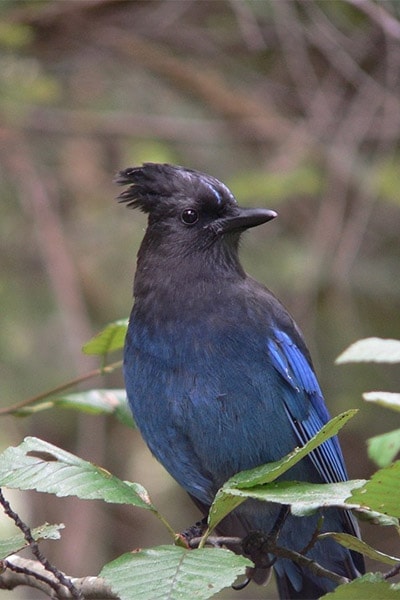
photo credit: Daniel Köchli from Pixabay
Blue Jays are also omnivores like a lot of other birds. However, some would also consider them as opportunistic feeders because they eat whatever is available to them.
Their strong beaks allow them to crack open nuts. They also eat berries, seeds, corn, insects, and eggs. However, there are also times that they eat smaller animals like lizards, insects, frogs, and small rodents.
Fortunately, their diet comprises 75% plant material, especially in winter when berries and seeds are the majority they can find. And the rest would be insects. There are instances when Blue Jays would raid nests and eat nestlings or baby birds, but this happens rarely and is mostly in areas where there’s a low food supply.
They also sometimes store food like acorns on the ground, but they quickly forget where they are.
Nesting Data
- Clutch Size: 2-7 eggs
- # of Broods: 1 brood
- Incubation Period: 17-18 days
- Nestling Period: 17-21 days
- Egg Description: Bluish or light brown with dark spots
Nesting
Blue Jays are known to be monogamous birds, pairing for life. They normally build their nests 8 to 30 feet high above the ground on thick outer branches of deciduous or coniferous trees.
The pair works together to build the nest, with the male gathering the materials and the female putting it together. It’s constructed like a bulky open cup made of twigs, leaves, grass, weeds, bark strips, and moss. This is then held together with mud.
The lining is usually made of fine materials, and sometimes the birds decorate it with paper, strings, rags, and other things they can find.
Blue Jay Behavior
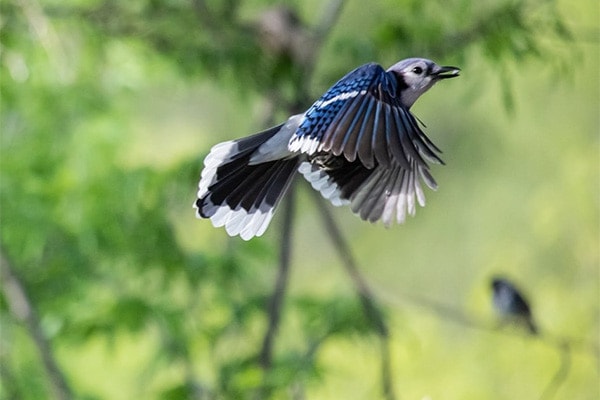
photo credit: Gerhard Crous on Unsplash
Blue Jays are probably one of the most well-known and well-researched birds. They are very noisy and often drive other birds away from feeders and territories. This is especially during the breeding season, where their vocals are heard clearly.
They are known to have amazing vocal ranges and can even mimic human speech and cats’ meows. They are also excellent in mimicking a hawk’s sound, which effectively makes birds scatter away from feeders or warning other birds about a predator coming.
During the winter, Blue Jays are known to store more food than they can eat. They sometimes store 2-3 acorns in their pouch, one in their mouth, and one at the tip of their bill. However, it’s questionable if this is to prepare themselves for harsher weather conditions or just to discourage intruders from coming into their territories.
Tips for Birdwatchers On How To Attract Blue Jays
Not many people love attracting blue jays because they are considered “bullies” in the avian world. However, if you want to attract a blue jay to your backyard, you would need to meet their every need, and these would be food, water, and shelter.
Start by choosing a Blue Jay-specific feeder. These usually are larger than most feeders for other songbirds, giving them more freedom to move and jump around. Once you find that, fill it with Blue Jay’s favorite foods.
These could be:
- Sunflower seeds
- Peanuts
- Corn
Next, make your backyard a suitable habitat, too. This way, you can see Blue Jays fly around and sing on tree branches. So, how about trying to plant oak trees or beech trees where they can spend a lot more time in. You can then place some sticks, twigs, and grass clippings around your backyard to encourage nesting.
Finally, don’t forget to provide water for bathing and drinking.
You should also remember to keep your distance, so you don’t scare the bird away.
Threats To The Blue Jay
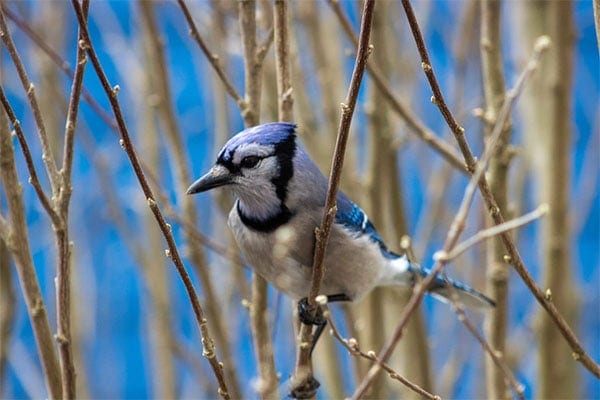
photo credit: Aaron Doucett on Unsplash
The Blue Jay population has widely decreased between the years 1966 and 2015. However, they still belong to the “least concern” conservation group as they are mainly widespread.
Blue Jays are facing a lot of threats, mainly because of human activities. These include loss of habitat, hunting, pesticides, and deforestation. Other threats include collisions with man-made structures and being hunted by predators like hawks, falcons, and owls.
Fun & Interesting Facts
- Blue Jay’s feathers aren’t blue; it’s a trick of the light, and their feather is really brown.
- The oldest wild Blue Jay is 26 years and 11 months old.
- The Blue Jay is the provincial bird of Prince Edward Island in Canada.
- These birds are the symbol of the Toronto Blue Jays major league baseball team.
- They can imitate the sound of hawks when spotted, making them alarm systems for other birds.
- Blue Jays have a pack mentality, which makes them bullies of other birds.
- They are very loud.
- Blue Jays engage in anting; they spread their wings, tuck their tail down, and crush or rub the ants on their feathers.
Explore More Species in This Family
- Canada Jay
- Green Jay
- Steller’s Jay
- Florida Scrub-Jay
- California Scrub-Jay
- Woodhouse’s Scrub-Jay
- Mexican Jay
- Blackbilled Magpie
- Yellow-billed Magpie
- Clark’s Nutcracker
- American Crow
- Northwestern Crow
- Fish Crow
- Chihuahuan Raven
- Common Raven
The post Blue Jay: Bird Identification, Habits, Facts, Nesting appeared first on BirdInformer.com.
from BirdInformer.com https://ift.tt/3eaNvzt

No comments:
Post a Comment